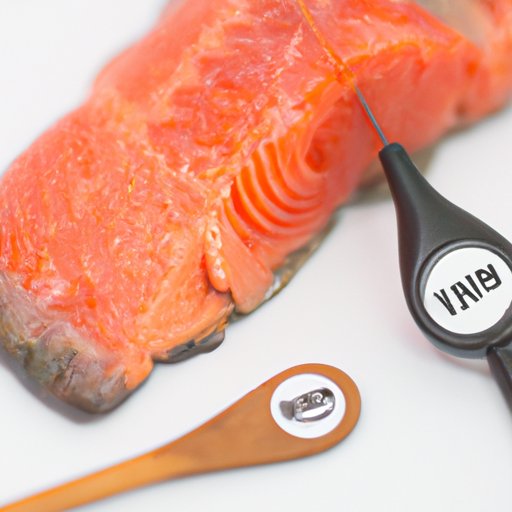Introduction
Salmon is a delicious and nutritious fish that’s perfect for any meal. However, for many home cooks, determining when salmon is done can be challenging, leading to undercooked or overcooked fish. This article will provide comprehensive methods for knowing when salmon is done, including cooking time and temperature, the “poke test” method, coloration, meat thermometers, different cooking methods, and smoked salmon.
Recommended Cooking Time and Temperature for Salmon
Before cooking salmon, it’s essential to have a basic understanding of the recommended cooking time and temperature. The precise cooking time and temperature can vary depending on the size and thickness of the salmon, cooking method, and personal preference. Generally, one rule of thumb is to cook the salmon at 450°F for 12-15 minutes per inch of thickness. This temperature range ensures that the inside of the fish is at a safe temperature of 145°F.
The “Poke Test” Method for Checking if Salmon is Done
The “poke test” method is a quick and easy way to check if the salmon is done. To perform the poke test, gently press the flesh of the salmon with a fork or knife and see if it flakes. If the flesh flakes easily, the salmon is done. If the flesh is still firm and the flakes are not separate, it may need more cooking time.
Determining Salmon’s Doneness Based on Its Color
Another way to check if salmon is done is based on its coloration. Fully cooked salmon should have a uniform pink coloration all the way through. If the salmon still shows a translucent or darker color in the middle, it may require additional cooking time.
Using a Meat Thermometer to Check for Salmon’s Internal Temperature
For those who want to be extra careful, using a meat thermometer is an effective way to check for salmon’s internal temperature. The USDA recommends a minimum internal temperature of 145°F to ensure that the salmon is cooked safely. Insert the thermometer at the thickest part of the fish to obtain an accurate reading. Be sure not to touch the bone or the bottom of the pan, as this can interfere with the reading.
Cooking Salmon in Different Ways and Impact on Cooking Time and Doneness
Cooking salmon in various ways, such as oven, stovetop, or grill, can impact cooking time and methods for determining doneness. Most cooking sources have different heat outputs that can change how quickly salmon cooks. It’s important to adjust the cooking time and temperature accordingly to avoid undercooked or overcooked fish.
How to Know When Smoked Salmon is Done
Smoking salmon can alter its appearance, making traditional checks such as coloration difficult to use. One way to determine whether smoked salmon is cooked is to check if it has reached an internal temperature of 145°F or above. Another way is to check if it’s firm and still has a moist texture.
Conclusion
Determining when salmon is done can be tricky, but using the methods explored in this article can help achieve perfectly cooked fish every time. Remember to adjust cooking time and temperature when cooking salmon in different ways and to use a meat thermometer to ensure safety. Experiment with different methods to find the one that works best for you, and enjoy your perfectly cooked salmon.
